
Polikarpov PO2
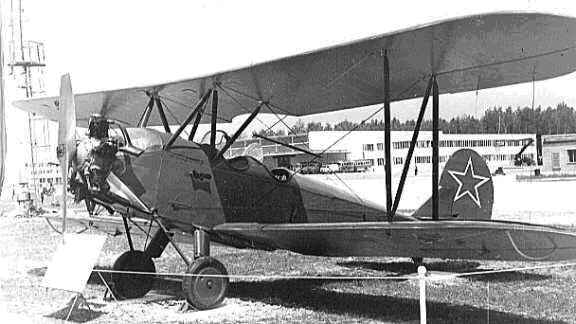
Among the thousands of types of airplanes built during the first century of aviation, many were fine, but a few were truly outstanding. Some of these were glamorous and received immidiate fame, like the Supermarine Spitfire or the Focke-Wulff 190, others blended in with the wallpaper and only in hindsight do we realize that they must have been something special. One example of the latter is the Douglas C47 Skytrain. Another is the Russian Polikarpov PO2 (or U2). If you are an American or Western European, chances are you have never heard about the PO2. On the other hand, if you were on the German side on the Eastern front, the name PO2 or "Nдhmaschine" may even now bring you dreadful memories of clattering engines passing low overhead and exploding bombs depriving you and your exhausted fellows of precious sleep. One of the roles of the PO2 was nuisance attacks at night coming in low and dropping 20kg fragmentation bombs. The physical effect of this bombing may have been limited, but its main purpose was to push already tired, nerve-wrecked soldies, desperately trying to get some some rest, nearer to the limit of their endurance. But, let's start at the beginning:
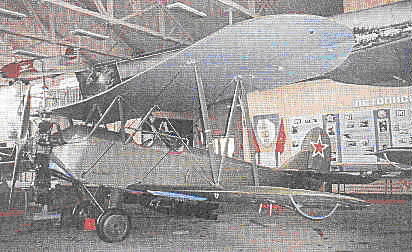
A 1928 Polikarpov PO 2 in Russian Space Museum.
The Polikarpov, named after its constructor, was designed in 1926. After an initial prototype had been a partial failure, the final model, flying for the first time on January 7th 1928, proved a success right from the start. A fairly small biplane with two open cockpits and a radial engine, it looks like many other types of its day, but there is a sort of rough elegance over its rounded-tip wings, tall rudder, and the uncowled five cylinder radial driving a two-blade fixed-pitch wooden propeller. The PO2 (this designation was given to it after Polikarpov died in 1944) was originally intended as a trainer and scout aircraft, but over the years, it was called to fill numerous roles: Night bomber, courier, general transport, ambulance plane, and several others. The rugged, cheap, and easy to maintain plane could operate from fields, roads, or clearings, and despite quite inadequate armour, it had few vulnerable parts (these being mostly the fuel tank, parts of the engine, and - the pilot). The wood and fabric construction was invisible to the radars of that time, and pilots might even cut the engine gliding soundlessly in for some of the World's first stealth attacks. While one rifle bullet in just the right place could bring it down, at other times hundreds of bullets, and even grenades, might pass through the fabric covered parts of fuselage and wings without seriously impairing the plane's airworthyness.
Rebuilt unit
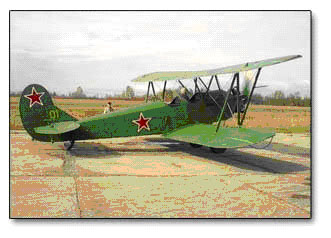 |
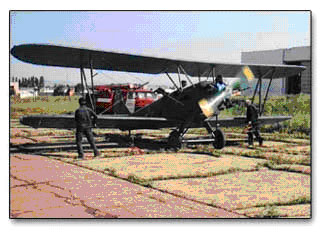 |
| Taxi test-April 2002 |
Preparing for test flight |
And the PO2 was a pilot's plane to fly: Highly maneuverable, yet stable and predictable. It was virtually impossible to spin accidentially, and when in an induced spin would pull out on its own when control surfaced were put to neutral. When climbing too steeply, it would not stall, but gently lower its nose to pick up speed again. Even against WW2 fighters it had one edge. One German pilot tells the story of how he one night happened to spot a PO2 as it passed from a dark to a light part of the moonlit landscape below him. He turned his Me109 around, lined up behind the PO2, -- and overshot it! He came back round, lowering flaps and gear to try and match speed with the slow biplane, got his aim and fired. The recoil of his powerful guns killed the last of his speed and he stalled and crashed. Back from the infirmery several months later, he learned that he had actually been credited for shooting down a PO2 -- at the expense of a much more costly and much less replaceable Me109! Actually, apart from its suitability for its specific battle role (harrassment bombing over the vast Eastern Front), what made the PO2 such a surprisingly potent weapon was surely its expendability! It could be built and maintained at a fraction of the price of, say, an Me109, and easy to fly (it was originally built as a primary trainer), pilots could be ready for operations before a fighter pilot was ready for his first solo. And the Russians had a virtually unlimited supply of people! Even the attrition from accidents in night sorties against low-flying targets would, given time, have proven unbearable for the Germans, whereas the Soviets could have kept the little biplanes coming indefinitely. It is not always the superior technology that wins a battle!
Die Nachthexen (the night witches): The 586th / 587th / 588th Night Bomber Regiments had female pilots (when it comes to the rough jobs, the Russians have always been far ahead in sexual equality). These women flew their PO2's with great skill and courage, thus deserving their German nickname. Difficult to attack by modern fighters, invisible to WW2 era radar and infrared sensors (the small, low-powered engine gave off too little heat), the only effective countermeasure against nightly PO2 attacks was heavy concentrations of searchlights and flak, and even that was not easy because the "Sewing Machines" flew so low. To make matters worse for the enemy, the Nachthexen emlpoyed a daring, but efficient tactic:
They would attack in groups of three, one trailing somewhat behind the others. Once having attracted the searchlights, the two first machines would seperate and concentrate on using their excellent maneuverability to evade the flak and searchlights, while the third sneaked in and dropped its bombs. Then they would change roles till all had delivered their loads.
The PO2 stayed in production into the fifties and was in the Soviet Air Force ranks long enough into the cold war to merit a NATO designation, "Mule". The Russians nicknamed it "Kukuruznik" (Corn Cutter). The German soldiers called it "Nдhmaschine" (sewing machine), both names may have been inspired by the clatter from slow-running five cylinder engine. Between 30,000 and 40,000 were built, a handful are still flying to-day, some with the original engine. The great numbers built and the long service time proves that this plane must have been truly excellent in its field. The name "Mule" seems extraordinarily appropriate for this little aircraft: Undemanding, unglamorous, durable, efficient, and forgiving. Yet at times able to deliver a nasty kick!
Other sights:
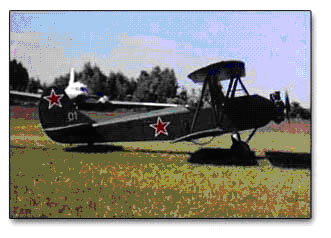 |
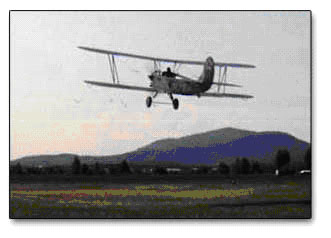 |
| First test flight |
Take-off |
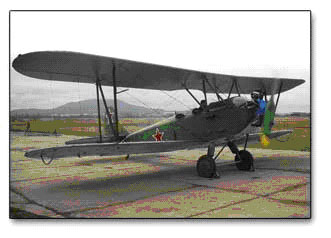
Taxiing for take-off
Data:
-
Wing span: 11.40 m
-
Length: 8.17 m
-
Height: 3.10 m
-
Wing area: 33.15 m2
-
Operating weight: 890 kg
-
Bomb load: 250kg
-
Maximum speed at 1 000 m: 148 km/h (105mph)
-
Time to 2000 m: 13 min
-
Ceiling: 3800 m
-
Range: 450 km
-
Power plant: one Shvetsov M-11, 5-cylinder air-cooled radial engine, output 100 hp (later versions 145hp)
Now for this CFS version: The normal armament was one ring-mounted 7.62mm machine gun in the rear cocpit. I have retained that, pointing it 10deg upwards, so you can try and fight off attackers on your six. But what is a CFS plane without forward guns? Surely some of the 30-40,000 PO2 were at some time fitted with a couple of forward-firing machine-guns? Well - anyhow, this one is; two 7.62 guns close-set in front of the forward cockpit firing through the propeller. Finally, it can take up to six light bombs (default is zero). If you choose to take off with full bomb, ammo, and fuel load, you will have one heavy little bird on your hands, but otherwise you will find that the CFS PO2 lives up to its real-life origin: Maneuverable, but forgiving and easy to fly. Watch it when landing: The PO2 flares out at around 45mph, so if you come down at the 75+ you are used to when flying WW2 fighters, it will just fly on and on and on. I have modified the airfile from the FS98 version because it had some quirks; first of all, there was the usual problem of it being designed with ordnance weight included. In CFS, the airfile must be designed with the empty weight, as ammo weight is derived from the damage profile, otherwise the loaded plane will be overweight. Also, it had a fantastic roll rate, something like a Fokker DR1! I have not been able to get info of the true roll rate of the PO2, but I have reduced it to something that felt more right. I have equipped it with the 145hp engine of the later productions (after 1943, it would seem).
You will find it much too slow for escort and interception, but in the ground attack role it is terrific, and AI fighters trying to intercept it really have their hands full if you exploit the special abilities of the PO2: Quick turns at almost zero altitude. A tip for bombing: To stay as safe as possible against fighters and AAA, approach targets at VERY low altitude, 30ft or less. But if you drop bombs from that altitude, you will be killed in the blast! So I do this: Just before reaching the target, I pull up sharply and release the bombs (one or two), effectively lobbing them into the target, then immidiatly do a wing-over, put the nose back to the ground and fly away without passing over the target.
Multiplayer bomb. This plane had been equipped with a bomb simulator for multiplayer. A cannon array facing down and with ballistic characteristics close to that of a bomb will work in multiplayer and simulate the effect of a bomb. The visuals are somewhat special, but have been maintained to make the device visible lest it be used against planes, which is considered a cheat.
And a final note: The PO2 has a very effective rudder (surely realistic, look at how huge it is), but this requires you to have rudder control, either as pedals or a twist-stick. If you fly it with auto-rudder, you only get half the pleasure from it.
The information above has been compiled from numerous sources. Some of the sources differ on some details; in these cases, I have either chosen the version given by most sources, or I have simply made my own choice. For instance, the only place I have found mention of the version with 145hp is in Jane's, but I have included it in my model because it makes for more virtual flying fun. All this means that you must not threat this as a historical document, just as a collection of more or less verified facts.
If you are just interested in aviation history, I hope I have conveyed some interesting information on an outstanding little aircraft. If you are a CFS pilot, I hope you will have additional pleasure trying out an unusual and surprising little bird in the virtual sky.
Hans Egebo / MRC_Hans